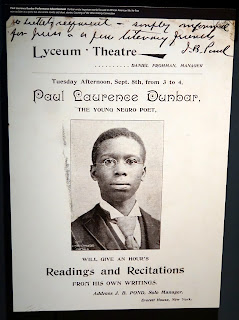Last Fall I was among the crowds on the mall to witness the opening of the new National Museum of African American History and Culture, The Blacksonian as we've come to call it in the months since. Perhaps most moving of all was seeing the numbers of people with their walkers and wheel chairs, some of them people who had been here for the March on Washington, come back to the nation's mall a half century on to mark the long awaited opening of this monument to a too neglected history. Now, as the AWP was winding down, I finally had an opportunity to enter this museum for myself.
Like most, I worked my way up from the bottom, starting in the lower depths, in the darkness, confronting the relics of a slave ship, placards noting the histories and cultures of Africa from which the first African Americans had been violently ripped. Fitting that the tour that begins with the slave ship can end, many floors above, with the Mother Ship, astral sign of the bottomless creativity and unbounded aspirations of a people.
There were a lot of us that day, as every day, and some found curious the fact that I seemed to be taking photos mostly of documents and books. Couldn't I have read them in a library? I could have, and have . . . but seeing them here meant something different.
Seeing for example that familiar chart that had been such a powerful tool in the Abolitionist struggle, unfolding from its book as so many had read it then -- Seeing the handwriting on a slave owners inventory, followed by an original copy of Banneker's almanac, or a first edition of Phillis Wheatley's poetry, or a proclamation made by Toussaint Louverture . . .
and here in a case lay Nat Turner's Bible!
As you work your way up through the floors of the museum, you slowly ascend into your lived history, no matter how young you might be. I was already feeling the waves of recognition and pain seeing the room dedicated to Emmet Till, passing the model of a mid-century lunch counter, pausing in front of the case that contained the Klan's by-laws. But the museum's designers have given us a true ascent; as you rise within the building, you witness the rise through freedom to a possible future.


and so my long walk up through the building's exhibits eventually brought me not only to people I have known, but to events I was part of -- Like African Liberation Day, 1977. Today's gentry may have reverted to calling it Meridian Hill Park, but to those of my generation it is still Malcolm X Park, and that's where we gathered, year after year.










































No comments:
Post a Comment